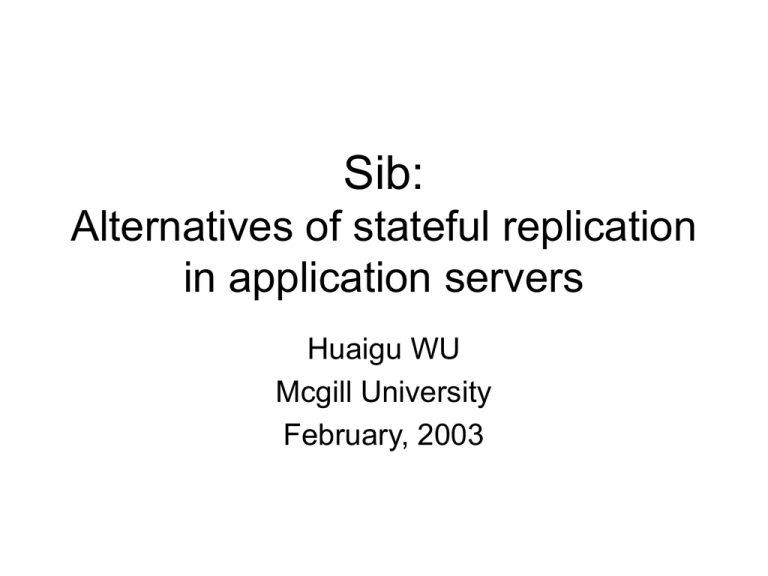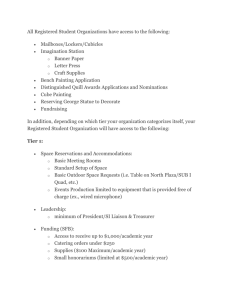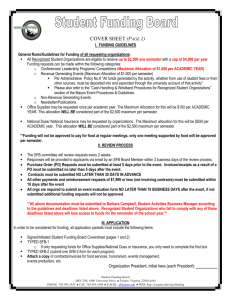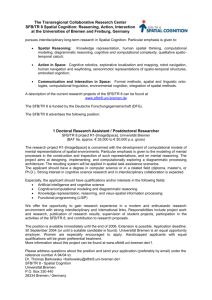
Sib:
Alternatives of stateful replication
in application servers
Huaigu WU
Mcgill University
February, 2003
Purpose of Sib
• An alternative approach to implement
replication in application server
– Abstract level (derived from the J2EE
specification)
– Focus on Stateful Session Bean
– Will extend to Stateless Session Bean and
Entity Bean
Outline
• Sib VS. JBoss
implementation
– Simple Calls
– Calling Hierarchies
– Direct Database
Access
Client
1
2
Application Server
SFB 1
Client
1
4
Application Server
SFB 1
Client
• Compare
– Normal process
– Site crash and
failover
2
3
1
4
Application Server
SFB 1
3
2
SFB 2
Data
Assumption
• We don’t consider partition.
• Abstract component architecture
– Component in this talk consists of client, Stateful
Session Bean (SFB) and third-party database
• Third-party database will be used without
modification
• Deterministic component for basic analysis
• One primary, one (or more) backup
• So far, we assume every component is single
threaded
Normal Processing in Simple Calls
(JBoss)
• Only primary receives and
processes request
• Replicate primary’s up-todate state to backups at the
end of every request before
returning its reply
• Backup updates state after
every request
Client
1
3
4
6
Cluster
SFB 1
SFB 1
Primary
Backup
2
5
Normal Processing in Simple Calls (Sib)
• Independent for
component
• Deterministic component:
it could be any time point
3
Client
1
• At the beginning, states of all
replicas are the same
• request is broadcast to both
primary and backup
• Primary processes requests
• Backup receives requests
• Occasionally (periodically),
Primary’s state is replicated to
backup
– Replication Point
(operational quiescence )
2
4
Cluster
SFB 1
SFB 1
Primary
Backup
0
4'
Comparison
• Network overhead for one component
– Message types:
• Request (req), Reply (rep), Replicated state information (s)
– Message size: s >> req
• JBoss analysis: s = 2-3 KByte
– Message number (N is number of sites)
• JBoss: 1 request: 1 req + 1 rep + N*s
• Sib: 1 requset: N req + 1 rep + q * N * s (q is the frequency of
replication, q<=1)
• Compare: JBoss > Sib
• Backup’s CPU overhead
– JBoss: receive and install state
– Sib: receive requests
– Assume install state > install request, so JBoss > Sib
Site Crash and Failover for Simple Calls
(JBoss)
• Characters
– When primary fails, client resends
request to the new primary
• Issues
Client
3
1
Resend 1
Cluster
– Resend must be repeatable
• Content
– Duplicated requests must be
identified by SFB
Client
SFB 1
SFB 1
Backup
Primary
2
Client
Identify duplicated request 1
(Does JBoss do it ?)
3
1
Cluster
SFB 1
Primary
3
1
Cluster
Resend 1
SFB 1
Backup
2
Resend 1
SFB 1
SFB 1
Primary
2
Backup
Site Crash and Failover for Simple Calls
(Sib)
• Issues
– Duplicated replies must be
identified by client
– Replies must be deterministic
1
– When primary fails, the new
primary automatically reexecutes all requests starting
from last replication point
– Client does not need to resend
request
2
Execute
request 1
Cluster
SFB 1
SFB 1
Backup
Primary
Identify duplicated reply 2
(testable result)
Client
1
• Characters
Client
2
Execute
request 1
2
Cluster
SFB 1
Primary
SFB 1
Backup
Normal Processing in Calling Hierarchies
Client
1
Client
6
1
4
Cluster
Cluster
SFB 1
5
2 4
Primary
3
SFB 2
SFB 2
3
JBoss
SFB 1
2
SFB 1
Backup
SFB 1
0
SFB 2
SFB 2
Primary
0
3'
Sib
Backup
Site Crash and Failover for Calling
Hierarchies (JBoss)
• Assumption
• Issues
– Node fails (all beans in the node fail)
– Duplicated internal
requests must be
identified by SFB
• Characters
– Similar to simple calls for one
component
Client
Client
Client
Resend 1
1
2
Primary
4
5
SFB 2
Backup
3
2
6
Resend 1
1
Cluster
SFB 1
SFB 1
2
SFB 2
Resend 1
1
Cluster
Cluster
SFB 1
Duplicated
internal
request 2
6
6
24
4
5
SFB 2
SFB 2
Primary
SFB 1
SFB 1
3
Backup
2
4
SFB 1
5
SFB 2
SFB 2
Primary
3
Backup
Site Crash and Failover for Calling
Hierarchies (Sib)
• Assumption:
• Issues
– Node fails (all beans in the node fail)
– Duplicated internal requests
must be identified by SFB
– Duplicated internal replies
must be identified by SFB
• Character:
– Every backup SFB re-executes
requests starting from its own
last replication point
7 0
23
67
SFB 2
SFB 2
Primary
Backup
0
3'
SFB 1
6
Discard
duplicated
internal
requests
5
1
Re-execute
request 6
8
4
3
7
SFB 1
0
4'
3
67
SFB 2
SFB 2
Primary
Backup
0
Duplicated
internal
replies
Duplicated
internal
request
SFB 1
6
Identify
duplicated
internal
requests
Duplicated
reply 8
Cluster
2
1
SFB 1
6
2
Re-execute
request 2,6
Cluster
SFB 1
3
Duplicated
reply 8
Re-execute
request 5
Client
8
4
Cluster
2
1
5
Duplicated
reply 8
Duplicated
reply 4
8
4
Re-execute
request 5
Client
5
Client
3
7
SFB 1
0
Duplicated
internal
request
4'
67
SFB 2
SFB 2
Primary
Backup
0
3'
Direct Database Access (JBoss)
• Normal process
• Failover
– NO “Exactly-once” Semantic
Client
Client
3
2
Primary
te
Wri
te
Wri
and
co m
it
Ackcomm
and
Resource Manager
(Resource Adapter)
Backup
SFB 1
SFB 1
nd c
o
Ack mmit
SFB 1
SFB 1
Primary
Resend 1
1
Cluster
3
mi t
Writ
ea
1
Cluster
Data
Data
Backup
2
Possible duplicated
database access
Direct Database Access (Sib)
Client
– Data bind to specified
Resource Manager
1
• Normal process
2
Cluster
– All requests to some
data is forwarded to its
specified RM
Ack
SFB 1
0
RM
RM
Primary
ite
Wr
Backup
0
t
Ackommi
&C
– Focus on write
operation
SQL
SFB 1
Data
Direct Database Access (Sib)
• Failover suggestion 1
– Characters
– Conclusion
• Simple during normal
process
• Complex during recovery
1
Duplicated internal
SQL request
Cluster
SFB 1
0
Generate
undo
RM
Primary
0
Re-execute
SQL request
SFB1
SQL
&
ite
Wr mit
m
Co
• Tables must have primary
key to be able to generate
undo
• In case primary committed,
other access between
commit and undo might be
possible
2
Ack
RM
Undo
t
rollba o
c
k
(re p e
atable
)
Ack
Write
& Com
mit
Ack
– Issues
Re-execute
request 1
SQL
• Write bind to commit
• Converse Undo, start from
the last write.
• If original write is successful,
undo rollback it.
• If original write is failed,
undo has no effect.
Client
Data
Backup
Direct Database Access (Sib)
• Failover Suggestion 2
– Characters
1
SFB1
0
Ack
SQL
RM
0
Mark
Exist?
k
Primary
Data
Redo
if no m ,
a rk
RM
Ack
• Complex during normal
process
• Simple and correct
during recovery
SFB 1
mi t
co m
e rt
Ins k
r
Ma
te
Wri
– Conclusion
Cluster
k Ma r
• additional insert
overhead In normal
process
• RM must maintain global
transaction ids
Duplicated internal
SQL request
Chec
– Issues
Re-execute
request 1
2
SQL
• Insert Additional mark
before every commit
• If mark exists, redo is not
required
• If mark does not exist,
redo
Client
Backup
Summary
• Sib’s Advantage
– Better performance
• State information (including response information) is much
bigger than request
• Infrequent replication points enough since EJB is short-living
so that failure is unlikely
– More powerful for “Exactly-once” database access
• Sib’s Disadvantage
– More complicated recovery
– Duplicated external responses
• Client needs to remove duplicated responses
Current Work
• Compare schemas for complex transactions
– A transaction crosses several requests
– Entity beans replication in complex transactions
• Multi-Thread: Typical Non-deterministic environment
– Multi-Thread Client / Single-Thread SFB
• JBoss:
– Repeatable request might be problematic (e.g. resend in different order)
• Sib
– Avoid resend requests
– Total order o requests in all replicas
– Multi-Thread Client / Multi-Thread SFB
• Both JBoss and Sib might be problematic
– Sib: special concurrency control and synchronous mechanism
• Component Failure
Problematic Example under MultiThread Environment
Client
Resend 1
1 2
Cluster
X=3
Resend 2
X=0
X=0
S1
X+3
S2
X-3
S2
X-3
Backup
Primary
2
X=-3
Reference
•
•
•
•
•
•
•
•
[1] W.Zhao, L.E.Moser and P.M.Melliar-smith, “Unification of Replication and Transaction
Processing in the Three-Tier Architectures”, 22nd International Conference on Distributed
Computing Systems (ICDCS'02), Vienna, Austria, July 02 - 05, 2002.
[2] Marcia Pasin, Michel Riveill and Taisy Silva Weber, “High-Available Enterprise
JavaBeans Using Group Communication System Support”, Proceedings of the Fourth
European Research Seminar on Advances in Distributed Systems - ERSADS 2001, pages
161-166, University Residential Center of University of Bologna, Berliner (Frolic), Italy, 1418 May 2001.
[3] Roger Barga, David Lomet, Gerhard Weikum, “Recovery Guarantees for General MultiTier Aplications”, Proceedings of the 18th International Conference on Data Engineering
(ICDE'02)
[4] P.Narasimhan, L.E.Moser and P.M.Melliar-smith, “State Synchronization and Recovery
for Strongly Consistent Replicated CORBA Objects”, International Conference on
Dependable Systems and Networks, Göteborg, Sweden (July 2001).
[5] N.Narasimhan, L.E.Moser and P.M.Melliar-smith, “Transparent Consistent Replication
of Java RMI Object”, DOA 2000: 17-26
[6] Svend Frølund, Rachid Guerraoui, “e-Transactions: End-to-End Reliability for ThreeTier Architectures”, TSE 28(4): 378-395 (2002)
[7] Svend Frølund, Rachid Guerraoui, “Implementing e-Transactions with Asynchronous
Replication”, IEEE Transactions on Parallel and Distributed Systems 12(2): 133-146 (2001)
[8] Object Management Group, “Fault Tolerant CORBA Specification”. December 1999,
OMG Technical Committee Document (orbos/00-04-04)
Reference
•
•
•
•
•
•
•
•
•
•
[9] IONA Technologies PLC, “White Paper Orbix E2A Application Load Balancing and
Fault Tolerance”, online documentation, http://www.iona.com/forms/wprequest.htm,
April, 2002.
[10] BEA WebLogic Server™, “Programming WebLogic Enterprise JavaBeans”,
Copyright © 2000 BEA Systems, Inc. All rights reserved.
[11] Gerhard Weikum, Gpttfried Vossen, “Transactional Information Systems: Theory.
Algorithms, and the Practice of Concurrency Control and Recover”, Morgan
Kaufmann Publishers, January 2002.
[12] Ed Roman, Scott Ambler and Tyler Jewell, “Mastering Enterprise JavaBeans
second edition”, Wiley Computer Publishing, John Wiley & Sons, Inc., ISBN: 0-47141711-4, December 2001.
[13] Sun Microsystems Inc., “Java™ 2 Platform Enterprise Edition Specification, v1.3”,
online documentation, http://java.sun.com/j2ee/, Oct. 20, 2000.
[14] Sun Microsystems Inc., “Enterprise JavaBeansTM Specification, Version 2.0”,
online documentation, http://java.sun.com/j2ee/, Oct. 23, 2000.
[15] R. Jimenez-Peris, M. Patino-Martinez, “Deterministic Scheduling and Online
Recovery for Replicated Multithreaded Transactional Servers”, WDMS 2002, June 26,
2002.
[16] Roman Vitenberg, Idit Keidar, Gregory V.Chockler and Danny Dolev, “Group
Communication Specifications: A Comprehensive Study”, In ACM Computing Surveys
33(4), pages 1-43, December 2001.
[17] Sacha Labourey, Bill Burke, “JBoss Clustering”, The JBoss Group, November
2002
[18] Andreas Schaefer, “JBoss 3.0 Quick Start Guide”, The JBoss Group, July 2002






